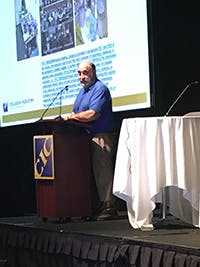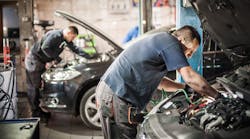ATLANTA — There is a forgotten word in collision repair — maintenance.
Toby Chess, with the Collision Industry Conference Technical Committee, offered safety and maintenance tips and expectations for ensuring shop safety. Chess presented at the quarterly Collision Industry Conference meeting, this one in Atlanta at the Georgia World Congress Center, held in conjunction with NACE Automechanika 2018, Aug. 7-8.
Chess stressed the vital importance of preventive maintenance in the shop — which involves a planned and controlled program of systemic inspections, adjustments, lubrication and replacement of components, as well as performance testing and analysis.
Chess encouraged attendees to perform preventive maintenance on the following items on a regular basis:
First aid kits — First aid kits need to be inspected to ensure all necessary items are included, up-to-date and available in the case of an injury.
Electrical panels — Ensure panels are not blocked by equipment carts, shelving or other shop equipment or parts. They should be fully accessible.
Fire extinguishers — These need to be inspected once a month and upgraded once per year by a licensed individual. Shops should also have a Class D fire extinguisher for any aluminum or magnesium fires. Extinguishers need to be accessible and not blocked in any way in the shop.
Product labels — Products need to be properly identified with a manufacturer label or OSHA-issued work place label to ensure correct identification and safety when handling.
Extension cords — Missing ground pins and loose cords are a safety hazard.
Overall Equipment Safety — Frame machines, spot welders, MIG welders, air compressors, air blowers, respirators, lifts and jacks, spray booths and more need regular inspections and review to ensure all parts are functioning and properly serviced and maintained. Technicians must also be provided with the proper
Welding gas cylinders — Need to be changed regularly, have a cap and be properly marked and stored.
Open containers — Keep containers properly sealed/closed.
Eye wash stations — Need to be approximately 10 feet from an area where eye exposure may occur. OSHA mandates that they must be inspected cleaned and solutions changed on a regular basis.
Paint suits — They must be breathable, comfortable and changed on a regular basis to ensure technician safety.
Carbone monoxide monitors — Monitors need to be included either in a spray booth or on a technician’s belt and inspected and serviced regularly.
Hazard materials storage — A spill containment vessel needs to be grounded and regularly emptied and cleaned.


